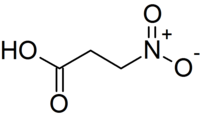
| |
| Names | |
|---|---|
| Preferred IUPAC name 3-Nitropropanoic acid | |
| Other names
3-NPA β-Nitropropionic acid Hiptagenic acid Bovinocidin | |
| Identifiers | |
| CAS Number | |
| 3D model (JSmol) | |
| ChemSpider | |
| ECHA InfoCard | 100.007.276 |
| PubChem CID | |
| UNII | |
| CompTox Dashboard (EPA) | |
InChI
| |
SMILES
| |
| Properties | |
| Chemical formula | C3H5NO4 |
| Molar mass | 119.076 g·mol |
| Melting point | 65–67 °C (149–153 °F; 338–340 K) |
| Except where otherwise noted, data are given for materials in their standard state (at 25 °C , 100 kPa). Infobox references | |
3-Nitropropionic acid (3-NPA) is a mycotoxin, a potent mitochondrial inhibitor, which is toxic to humans. It is produced by a number of fungi, and may be found widely in food such as in sugar cane as well as Japanese fungally fermented staples, including miso, soy sauce, katsuobushi, coconuts and some traditional Chinese medicines.
It can be caused by extreme weather, stressed crop growth conditions, as well as storage conditions (like moisture), which can give a further rise under global warming conditions. Fungi of the genus Arthrinium are known to produce 3-nitropropanoic acid.
It is found that 3-nitropropionic acid is a mitochondrial toxin and produces striatal alterations in rats similar to those observed in the brain of Huntington's disease patients, and administration of the cannabinoid receptor agonist WIN55212-2 to rats for six consecutive days, before the 3-NPA injection, exerted preventive effects on all alterations elicited by the toxin, like mitochondrial dysfunction and lipid peroxidation, by activation of the CB1 receptor.
References
- Roberts, Toby John (2004). "3-Nitropropionic Acid Model of Metabolic Stress: Assessment by Magnetic Resonance Imaging". Stroke Genomics. 104: 203–220. doi:10.1385/1-59259-836-6:203. ISBN 1-59259-836-6. PMID 15454669.
- Hocking, Ailsa D.; Pitt, John I.; Samson, Robert A.; Thrane, Ulf (29 August 2006). Advances in Food Mycology. Springer. ISBN 9780387283913.
- Birkelund, T.; Johansen, R. F.; Illum, D. G.; Dyrskog, S. E.; Østergaard, J. A.; Falconer, T. M.; Andersen, C.; Fridholm, H.; Overballe-Petersen, S.; Jensen, J. S. (2021). "Fatal 3-Nitropropionic Acid Poisoning after Consuming Coconut Water". Emerging Infectious Diseases. 27 (1): 278–280. doi:10.3201/eid2701.202222. PMC 7774558. PMID 33350928.
- Wang, X.P.; Yang, R.M. (2003). "Movement Disorders Possibly Induced by Traditional Chinese Herbs". European Neurology. 50 (3): 153–159. doi:10.1159/000073056. PMID 14530621. S2CID 43878555.
- Jensen, Ole (Jun 13, 2016). "Management of mycotoxin risk in pig production" (PDF). Powerpoint by Ole Jensen.
- Norbäck, Dan; Hashim, Jamal Hisham; Cai, Gui-Hong; Hashim, Zailina; Ali, Faridah; Bloom, Erica; Larsson, Lennart (2016-02-01). "Rhinitis, Ocular, Throat and Dermal Symptoms, Headache and Tiredness among Students in Schools from Johor Bahru, Malaysia: Associations with Fungal DNA and Mycotoxins in Classroom Dust". PLOS ONE. 11 (2): e0147996. Bibcode:2016PLoSO..1147996N. doi:10.1371/journal.pone.0147996. ISSN 1932-6203. PMC 4734676. PMID 26829324.
- Wei, D. L.; Chang, S. C.; Lin, S. C.; Doong, M. L.; Jong, S. C. (1994). "Production of 3-nitropropionic acid by Arthrinium species". Current Microbiology (USA). 28: 1–5. doi:10.1007/BF01575978. ISSN 0343-8651. S2CID 41489212.
- Maya-López, Marisol; Colín-González, Ana Laura; Aguilera, Gabriela; de Lima, María Eduarda; Colpo-Ceolin, Ana; Rangel-López, Edgar; Villeda-Hernández, Juana; Rembao-Bojórquez, Daniel; Túnez, Isaac (2017-02-15). "Neuroprotective effect of WIN55,212-2 against 3-nitropropionic acid-induced toxicity in the rat brain: involvement of CB1 and NMDA receptors". American Journal of Translational Research. 9 (2): 261–274. ISSN 1943-8141. PMC 5340665. PMID 28337258.
Further reading
- Huang, Li-Shar; Sun, Gang; Cobessi, David; Wang, Andy C.; Shen, John T.; Tung, Eric Y.; Anderson, Vernon E.; Berry, Edward A. (2006). "3-Nitropropionic Acid is a Suicide Inhibitor of Mitochondrial Respiration That, upon Oxidation by Complex II, Forms a Covalent Adduct with a Catalytic Base Arginine in the Active Site of the Enzyme" (PDF). Journal of Biological Chemistry. 281 (9): 5965–5972. doi:10.1074/jbc.M511270200. PMC 1482830. PMID 16371358.